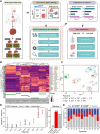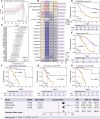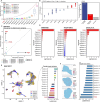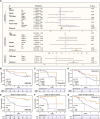A novel computational model ITHCS for enhanced prognostic risk stratification in ESCC by correcting for intratumor heterogeneity
- PMID: 39690882
- PMCID: PMC11652613
- DOI: 10.1093/bib/bbae631
A novel computational model ITHCS for enhanced prognostic risk stratification in ESCC by correcting for intratumor heterogeneity
Abstract
Intratumor heterogeneity significantly challenges the accuracy of existing prognostic models for esophageal squamous cell carcinoma (ESCC) by introducing biases related to the varied genetic and molecular landscapes within tumors. Traditional models, relying on single-sample, single-region bulk RNA sequencing, fall short of capturing the complexity of intratumor heterogeneity. To fill this gap, we developed a computational model for intratumor heterogeneity corrected signature (ITHCS) by employing both multiregion bulk and single-cell RNA sequencing to pinpoint genes that exhibit consistent expression patterns across different tumor regions but vary significantly among patients. Utilizing these genes, we applied multiple machine-learning algorithms for sophisticated feature selection and model construction. The ITHCS model significantly outperforms existing prognostic indicators in accuracy and generalizability, markedly reducing sampling biases caused by intratumor heterogeneity. This improvement is especially notable in the prognostic assessment of early-stage ESCC patients, where the model exhibits exceptional predictive power. Additionally, we found that the risk score based on ITHCS may be associated with epithelial-mesenchymal transition characteristics, indicating that high-risk patients may exhibit a diminished efficacy to immunotherapy.
Keywords: esophageal squamous cell carcinoma; intra-tumor heterogeneity; machine learning; prognostic prediction; sampling bias.
© The Author(s) 2024. Published by Oxford University Press.
Figures







Similar articles
-
Identification of Epithelial-Mesenchymal Transition- (EMT-) Related LncRNA for Prognostic Prediction and Risk Stratification in Esophageal Squamous Cell Carcinoma.Dis Markers. 2021 Oct 19;2021:5340240. doi: 10.1155/2021/5340240. eCollection 2021. Dis Markers. 2021. PMID: 34712369 Free PMC article.
-
Multi-omics analysis unveils a four-gene prognostic signature in esophageal squamous carcinoma and the therapeutic potential of PKP1.BMC Cancer. 2025 Apr 25;25(1):777. doi: 10.1186/s12885-025-14150-8. BMC Cancer. 2025. PMID: 40281492 Free PMC article.
-
Comprehensive Analysis of PD-L1 Expression, Immune Infiltrates, and m6A RNA Methylation Regulators in Esophageal Squamous Cell Carcinoma.Front Immunol. 2021 May 12;12:669750. doi: 10.3389/fimmu.2021.669750. eCollection 2021. Front Immunol. 2021. PMID: 34054840 Free PMC article.
-
Inter- and intratumor DNA methylation heterogeneity associated with lymph node metastasis and prognosis of esophageal squamous cell carcinoma.Theranostics. 2020 Feb 10;10(7):3035-3048. doi: 10.7150/thno.42559. eCollection 2020. Theranostics. 2020. PMID: 32194853 Free PMC article.
-
Imaging intratumor heterogeneity: role in therapy response, resistance, and clinical outcome.Clin Cancer Res. 2015 Jan 15;21(2):249-57. doi: 10.1158/1078-0432.CCR-14-0990. Epub 2014 Nov 24. Clin Cancer Res. 2015. PMID: 25421725 Free PMC article. Review.
References
MeSH terms
Substances
Grants and funding
- 82072557/National Natural Science Foundation of China
- 2021YFC2500900/National Key Research and Development Program of China
- 20XD1402300/Program of Shanghai Academic Research Leader from Science and Technology Commission of Shanghai Municipality
- 2022JC023/Novel Interdisciplinary Research Project from Shanghai Municipal Health Commission
- YG2023ZD04/Interdisciplinary Program of Shanghai Jiao Tong University
LinkOut - more resources
Full Text Sources
Medical
Miscellaneous

